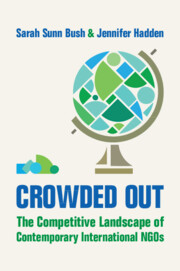2 - A Theory of INGO Populations
Published online by Cambridge University Press: 24 May 2025
Summary
This chapter provides an overview of our theoretical argument. We first discuss what international NGOs are and why they exist. Second, we argue that INGOs are motivated to survive to advance their ultimate goals related to social change. Third, we make the case that INGOs’ ideal strategies depend on the structure of the organizational population in which they operate. We draw particular attention to the role of population density (how many INGOs there are in a particular country, issue area, or both) and concentration (the share of revenues controlled by the largest INGOs in the sector). We argue that changes in these aspects of the population environment cause INGO entrepreneurs to make predictably different decisions about whether to found an organization, how specialized their mission should be, and where to locate their work globally.
Keywords
Information
- Type
- Chapter
- Information
- Crowded OutThe Competitive Landscape of Contemporary International NGOs, pp. 25 - 50Publisher: Cambridge University PressPrint publication year: 2025
- Creative Commons
- This content is Open Access and distributed under the terms of the Creative Commons Attribution licence CC-BY-NC 4.0 https://creativecommons.org/cclicenses/
